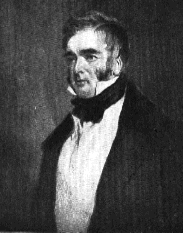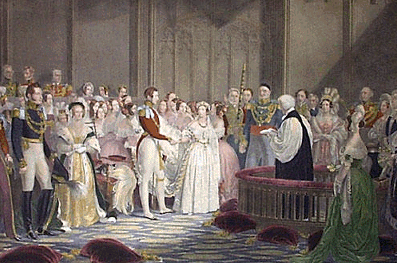 Upon becoming Queen, Victoria was finally able to break free from the influence of her mother and Sir John Conroy. An employee of Victoria's mother for many years, he resigned his post and left the country after being accused of an illicit affair with one of Victoria's ladies-in-waiting. Victoria treated the young woman badly. It wasn't until after the girl's death that it was determined that she
succumbed from a rare fatal disease at which time Queen Victoria deeply regretted her behavior in the Hastings affair.
Upon becoming Queen, Victoria was finally able to break free from the influence of her mother and Sir John Conroy. An employee of Victoria's mother for many years, he resigned his post and left the country after being accused of an illicit affair with one of Victoria's ladies-in-waiting. Victoria treated the young woman badly. It wasn't until after the girl's death that it was determined that she
succumbed from a rare fatal disease at which time Queen Victoria deeply regretted her behavior in the Hastings affair.
There were two major influences during the early part of Victoria's rule. The first was her Prime Minister, William Lamp (Second Viscount Melbourne), who became a valued friend and one Victoria relied upon heavily. He taught her much on the subject of constitutional government, lessons which served her well throughout her entire reign. The second was her Foreign Secretary, Henry John Themple, Third Viscount Palmerston. Lord Palmerston was the chief architect of Victorian foreign policy during the first part of Victoria's rule.
 In October 1839, Victoria's cousin, Prince Albert of Saxe-Coburg Gotha, visited England again and they fell madly in love with each other. She proposed marriage to him and he accepted. They were married on February 10, 1840. Victoria wanted Albert to be given the title King Consort, but British officials objected as they did not want to see a German prince assume the British throne. Despite her feelings for her husband, she did not speak much to him about political matters. Lord Melbourne did later persuade her to allow Albert to participate eventually. And with Albert's political influence, she came to share his fondness for the Conservative party.
In October 1839, Victoria's cousin, Prince Albert of Saxe-Coburg Gotha, visited England again and they fell madly in love with each other. She proposed marriage to him and he accepted. They were married on February 10, 1840. Victoria wanted Albert to be given the title King Consort, but British officials objected as they did not want to see a German prince assume the British throne. Despite her feelings for her husband, she did not speak much to him about political matters. Lord Melbourne did later persuade her to allow Albert to participate eventually. And with Albert's political influence, she came to share his fondness for the Conservative party.
Britain was undergoing many political and social changes. One of these concerned the role of the monarchy itself. Many wanted to divest the monarchy of all power and form a republican government. The 1830s and 1840s saw the rise of radical and extremely liberal Chartist movement, which called for universal male suffrage and for the reform of parliament. They also defended the working class interests and Chartist riots and workers' strikes occurred through Britain for many years. The movement did eventually die out in 1848.
The Corn Laws caused a major stir in the late 1830s. Believing them to have caused a severe trade depression, Prime Minister Peel repealed them in 1846. This year also turned out to be the worst year of the Irish potato famine resulting in the death of a million Irish and the emigration of a million and a half more in total, a full quarter of the population. The Whig government was blamed for the length of the famine due to its trade policies. The Queen did make a brief visit to Ireland, but did little to help. This problem would become an issue again later during her reign.
The first decades were marked by the advent of railways and steam power. Britain was fast becoming the most advanced industrialized nation in the world. By 1848, England produced half of the world's pig iron, possessed a booming shipbuilding industry and was home to a growing and prospering middle class. Population growth in London and Glasgow (Scotland) was increasing rapidly and Britain was becoming a country of town-dwellers, factory workers, and shop keepers as opposed to the nation of farmers it once had been. Workers living in the new industrial towns, however, very often resided in appalling slum neighborhoods, and had to face the problem with no political power and at the expense of powerful factory owners and increasingly cut-throat competition.
There were few foreign policy crises to deal with early in the period. Unlike its European neighbors, Victorian Britain was blessed with a long period of peace. Although not affected by the nationalist movements taking place in Italy, Germany and the Balkans, the Queen watched cautiously, especially the anti-monarchical movements.
Back to Intro/Index or Site Map
| | Family Gallery | Servants Parlour | Tour Home | Typical Day | Etiquette | Shopping Trip | |
| | Victorian Christmas | Victorian England Fun and Games | Ashton Library | Victorian Wedding | |
| | Victorian England Overview | Guest Registry | Honorary Victorian | Tours | |
| | Awards Received | Bibliography | |
| | 1876 Victorian England Home | |
Credits below copyright information |
| Contact
webmaster |
| Copyright
1999-2017 All Rights Reserved - B. Malheiro May not be reproduced in any way without express written permission of webmaster. |
Credits:
Background and buttons are the creation of webmaster, B. Malheiro. These images have been watermarked and are not for use on another site. Site authored by webmaster.